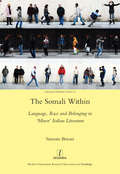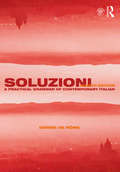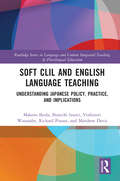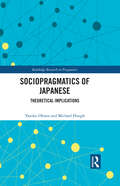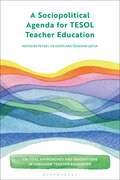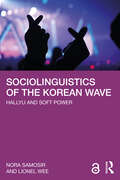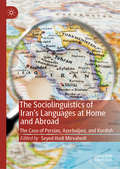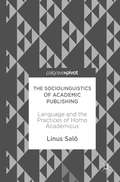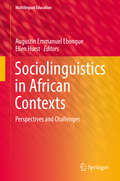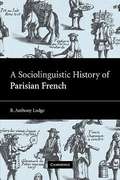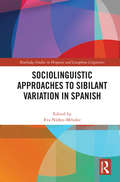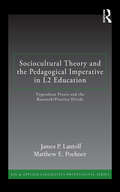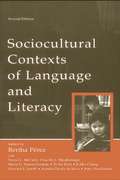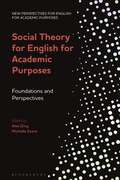- Table View
- List View
The Somali Within: Language, Race and Belonging in Minor Italian Literature
by Brioni SimoneThe recent histories of Italy and Somalia are closely linked. Italy colonized Somalia from the end of the 19th century to 1941, and held the territory by UN mandate from 1950 to 1960. Italy is also among the destination countries of the Somali diaspora, which increased in 1991 after civil war. Nonetheless, this colonial and postcolonial cultural encounter has often been neglected. Critically evaluating Gilles Deleuze and F x Guattari‘s concept ofminor literature as well as drawing on postcolonial literary studies, The Somali Within analyses the processes of linguistic and cultural translation and self-translation, the political engagement with race, gender, class and religious discrimination, and the complex strategies of belonging and unbelonging at work in the literary works in Italian by authors of Somali origins. Brioni proposes that theminor Somali Italian connection might offer a major insight into the transnational dimension of contemporaryItalian literature andSomali culture.
The Somali Within: Language, Race and Belonging in Minor Italian Literature
by Brioni SimoneThe recent histories of Italy and Somalia are closely linked. Italy colonized Somalia from the end of the 19th century to 1941, and held the territory by UN mandate from 1950 to 1960. Italy is also among the destination countries of the Somali diaspora, which increased in 1991 after civil war. Nonetheless, this colonial and postcolonial cultural encounter has often been neglected. Critically evaluating Gilles Deleuze and F x Guattari‘s concept ofminor literature as well as drawing on postcolonial literary studies, The Somali Within analyses the processes of linguistic and cultural translation and self-translation, the political engagement with race, gender, class and religious discrimination, and the complex strategies of belonging and unbelonging at work in the literary works in Italian by authors of Somali origins. Brioni proposes that theminor Somali Italian connection might offer a major insight into the transnational dimension of contemporaryItalian literature andSomali culture.
Soluzioni: A Practical Grammar of Contemporary Italian (Routledge Concise Grammars)
by Denise De RomeSoluzioni: A Practical Grammar of Contemporary Italian combines an engaging reference and practice grammar explained in clear and concise language with numerous supporting exercises. Aimed at keen students of all levels, Soluzioni offers: a complete grammar review in tabular form for easy navigation and at-a-glance comprehension; 650 graded practice exercises with an answer key for self-assessment; extensive examples, using a wide range of useful up-to-date vocabulary; authentic material from Italian media and literature, with vocabulary notes and linked exercises to show how grammar works in practice; special help sections throughout, dedicated to clarifying tricky points or avoiding common pitfalls; a comprehensive user-friendly index for ease of access in both Italian and English; a glossary of grammatical terms; a companion website at www.routledge.com/cw/derome with over 240 free interactive language quizzes for on-the-spot testing, plus supplementary downloadable material such as a comprehensive verb section and full answer key to the book exercises. This fourth edition continues the accessible methodology and focus on contemporary usage that has made Soluzioni the clearest and most comprehensive pedagogic grammar on the market today. Fully updated, it covers key areas of difficulty such as tense usage, the subjunctive, causative verbs, combined pronouns and word order. It also pays attention to the links between grammar and communicative functions as well as those between grammar, context and register. Suitable for class use and independent study, Soluzioni is the ideal reference and practice resource for learners of Italian. It is particularly suitable for fast-track use in ab initio courses at university and college.
Soluzioni: A Practical Grammar of Contemporary Italian (Routledge Concise Grammars)
by Denise De RomeSoluzioni: A Practical Grammar of Contemporary Italian combines an engaging reference and practice grammar explained in clear and concise language with numerous supporting exercises. Aimed at keen students of all levels, Soluzioni offers: a complete grammar review in tabular form for easy navigation and at-a-glance comprehension; 650 graded practice exercises with an answer key for self-assessment; extensive examples, using a wide range of useful up-to-date vocabulary; authentic material from Italian media and literature, with vocabulary notes and linked exercises to show how grammar works in practice; special help sections throughout, dedicated to clarifying tricky points or avoiding common pitfalls; a comprehensive user-friendly index for ease of access in both Italian and English; a glossary of grammatical terms; a companion website at www.routledge.com/cw/derome with over 240 free interactive language quizzes for on-the-spot testing, plus supplementary downloadable material such as a comprehensive verb section and full answer key to the book exercises. This fourth edition continues the accessible methodology and focus on contemporary usage that has made Soluzioni the clearest and most comprehensive pedagogic grammar on the market today. Fully updated, it covers key areas of difficulty such as tense usage, the subjunctive, causative verbs, combined pronouns and word order. It also pays attention to the links between grammar and communicative functions as well as those between grammar, context and register. Suitable for class use and independent study, Soluzioni is the ideal reference and practice resource for learners of Italian. It is particularly suitable for fast-track use in ab initio courses at university and college.
Soft CLIL and English Language Teaching: Understanding Japanese Policy, Practice and Implications (Routledge Series in Language and Content Integrated Teaching & Plurilingual Education)
by Makoto Ikeda Shinichi Izumi Yoshinori Watanabe Richard Pinner Matthew DavisContent and Language Integrated Learning (CLIL) is a transformative and powerful approach to language education and has had a significant impact on educational pedagogy in recent years. Despite burgeoning literature on the efficacy and implementation of CLIL, there remains a gap between CLIL and English Language Teaching (ELT). Many practitioners wonder how they can ‘do CLIL’ if their main classes are focused on English as a Foreign Language (EFL). This volume addresses these concerns by examining the experiences of various CLIL practitioners in the EFL context of Japan. Chapters outline the CLIL methodology, the differences in ‘hard CLIL’ (subject led) and ‘soft CLIL’ (language-oriented) before focusing on the EFL interpretations of soft-CLIL. Although the distinction of hard CLIL and soft CLIL has been mentioned in several publications, this is the first book-length exploration of this issue, featuring chapters examining expectations, challenges, material support, implementation, and even motivation in CLIL classrooms. All of this culminates in a review of the potential and future of CLIL in EFL contexts, paving the way for more widespread and well informed implementation of CLIL all over the world.
Soft CLIL and English Language Teaching: Understanding Japanese Policy, Practice and Implications (Routledge Series in Language and Content Integrated Teaching & Plurilingual Education)
by Makoto Ikeda Shinichi Izumi Yoshinori Watanabe Richard Pinner Matthew DavisContent and Language Integrated Learning (CLIL) is a transformative and powerful approach to language education and has had a significant impact on educational pedagogy in recent years. Despite burgeoning literature on the efficacy and implementation of CLIL, there remains a gap between CLIL and English Language Teaching (ELT). Many practitioners wonder how they can ‘do CLIL’ if their main classes are focused on English as a Foreign Language (EFL). This volume addresses these concerns by examining the experiences of various CLIL practitioners in the EFL context of Japan. Chapters outline the CLIL methodology, the differences in ‘hard CLIL’ (subject led) and ‘soft CLIL’ (language-oriented) before focusing on the EFL interpretations of soft-CLIL. Although the distinction of hard CLIL and soft CLIL has been mentioned in several publications, this is the first book-length exploration of this issue, featuring chapters examining expectations, challenges, material support, implementation, and even motivation in CLIL classrooms. All of this culminates in a review of the potential and future of CLIL in EFL contexts, paving the way for more widespread and well informed implementation of CLIL all over the world.
Sociopragmatics of Japanese: Theoretical Implications (Routledge Research in Pragmatics)
by Yasuko Obana Michael HaughObana and Haugh question the extent to which commonly accepted theories in pragmatics can readily explain sociopragmatic phenomena in Japanese. Studies of Japanese in pragmatics have often challenged the cross-linguistic relevance of dominant theories. However, they have also inadvertently perpetuated stereotypes about the Japanese. It is often been assumed, for instance, that Japanese people are less strategic, more polite and more reliant on tacit forms of communication than speakers of other languages. But the Japanese are not as polite as one might think. The aim of this book is thus to question those folk assumptions around politeness, impoliteness, irony and indirectness while at the same time emphasizing that close examination of sociopragmatic phenomena in Japanese yields important empirical insights that combat common theoretical assumptions in pragmatics. The content is structured in three parts, in which the authors highlight a key building block of a theory of sociopragmatics. Part I focuses on indexing through the lens of chapters on honorifics, routine formula and politeness strategies. Part II focuses on evaluating through the lens of chapters on giving/receiving expressions and honorific irony. Finally, Part III focuses on relating through the lens of chapters on joint utterances and off record requests. Throughout the chapters the authors draw attention to ways in which these three dimensions are invariably intertwined in various ways. This book is not simply a collection of studies that promotes our understanding of the sociopragmatics of a particular language, but goes deeper and challenges what many have taken for granted in pragmatics. It proposes a framework for exploring sociopragmatic phenomena, building on the key sociopragmatic axes of indexing, evaluating and relating, and offers fresh new perspectives on time-honoured phenomena in pragmatics. It will interest scholars and postgraduate students in pragmatics, particularly those specializing in: politeness, impoliteness, indirectness and irony. The book explains what Japanese terms mean, and all the Japanese examples are morphologically-glossed. Therefore, teachers (and advanced learners) of Japanese at all levels will benefit from the book as it will enrich their knowledge of the Japanese language.
Sociopragmatics of Japanese: Theoretical Implications (Routledge Research in Pragmatics)
by Yasuko Obana Michael HaughObana and Haugh question the extent to which commonly accepted theories in pragmatics can readily explain sociopragmatic phenomena in Japanese. Studies of Japanese in pragmatics have often challenged the cross-linguistic relevance of dominant theories. However, they have also inadvertently perpetuated stereotypes about the Japanese. It is often been assumed, for instance, that Japanese people are less strategic, more polite and more reliant on tacit forms of communication than speakers of other languages. But the Japanese are not as polite as one might think. The aim of this book is thus to question those folk assumptions around politeness, impoliteness, irony and indirectness while at the same time emphasizing that close examination of sociopragmatic phenomena in Japanese yields important empirical insights that combat common theoretical assumptions in pragmatics. The content is structured in three parts, in which the authors highlight a key building block of a theory of sociopragmatics. Part I focuses on indexing through the lens of chapters on honorifics, routine formula and politeness strategies. Part II focuses on evaluating through the lens of chapters on giving/receiving expressions and honorific irony. Finally, Part III focuses on relating through the lens of chapters on joint utterances and off record requests. Throughout the chapters the authors draw attention to ways in which these three dimensions are invariably intertwined in various ways. This book is not simply a collection of studies that promotes our understanding of the sociopragmatics of a particular language, but goes deeper and challenges what many have taken for granted in pragmatics. It proposes a framework for exploring sociopragmatic phenomena, building on the key sociopragmatic axes of indexing, evaluating and relating, and offers fresh new perspectives on time-honoured phenomena in pragmatics. It will interest scholars and postgraduate students in pragmatics, particularly those specializing in: politeness, impoliteness, indirectness and irony. The book explains what Japanese terms mean, and all the Japanese examples are morphologically-glossed. Therefore, teachers (and advanced learners) of Japanese at all levels will benefit from the book as it will enrich their knowledge of the Japanese language.
A Sociopolitical Agenda for TESOL Teacher Education (Critical Approaches and Innovations in Language Teacher Education)
by Peter I. De Costa and Özgehan UştukTeaching English to Speakers of Other Languages (TESOL) sits at the nexus of constant change, which makes it vitally important for language teachers to engage in continuous development and keep abreast of the sociopolitical milieu in which they are embedded. However, most teacher education activities are often associated with what is perceived as best practices that are expected to be adopted(often uncritically) for classroom application and practice, with the intention of training teachers to become technicians in their respective classrooms. In reality, TESOL practitioners often find themselvesin situations that require them to be reflexive practitioners and to negotiate sites of political struggles and social injustice.Given that a socially situated understanding of TESOL teacher education is often overlooked, this volume highlights the sociopolitical dimensions of TESOL teacher education. In Part 1, the authors introduce the theoretical underpinnings of the sociopolitical agenda proposed by this volume. Building on these theories, Part 2 realizes the proposed agenda by situating it within actual TESOL teacher education contexts that are characterized by power imbalances and neoliberally inflected educational injustices.
A Sociopolitical Agenda for TESOL Teacher Education (Critical Approaches and Innovations in Language Teacher Education)
Teaching English to Speakers of Other Languages (TESOL) sits at the nexus of constant change, which makes it vitally important for language teachers to engage in continuous development and keep abreast of the sociopolitical milieu in which they are embedded. However, most teacher education activities are often associated with what is perceived as best practices that are expected to be adopted(often uncritically) for classroom application and practice, with the intention of training teachers to become technicians in their respective classrooms. In reality, TESOL practitioners often find themselvesin situations that require them to be reflexive practitioners and to negotiate sites of political struggles and social injustice.Given that a socially situated understanding of TESOL teacher education is often overlooked, this volume highlights the sociopolitical dimensions of TESOL teacher education. In Part 1, the authors introduce the theoretical underpinnings of the sociopolitical agenda proposed by this volume. Building on these theories, Part 2 realizes the proposed agenda by situating it within actual TESOL teacher education contexts that are characterized by power imbalances and neoliberally inflected educational injustices.
Sociolinguistics of the Korean Wave: Hallyu and Soft Power
by Nora Samosir Lionel WeeSamosir and Wee examine how the immensely popular Korean Wave ("K-wave") also known as Hallyu is wielded as soft power through the use of communication for persuasion and attraction on the global stage. The Korean Wave refers to the global spread and popularity of South Korean culture, particularly its pop music ("K-pop"), serialised dramas ("K-dramas") and films ("K-films"). Given the South Korean government’s involvement in providing funding and publicity, the Korean Wave raises interesting sociolinguistic questions about the relationship between artistry and citizenship, the use of social media in facilitating the consumption of cultural products, and, ultimately, the nature of soft power itself. Studies of soft power have tended to come from the field of international relations. This book shows that sociolinguistics actually has a number of tools in its conceptual arsenal – such as indexicality, stance taking, affect, and styling – that can shed light on the Korean Wave as a form of soft power. As the first book-length sociolinguistic analysis of the Korean Wave and soft power, this book demonstrates how K-pop, K-dramas, and K-films have been able to encourage in consumers an anthropological stance towards all things Korean. This volume will be of particular interest to students and scholars in sociolinguistics, political science, cultural studies, and Korean studies.
Sociolinguistics of the Korean Wave: Hallyu and Soft Power
by Nora Samosir Lionel WeeSamosir and Wee examine how the immensely popular Korean Wave ("K-wave") also known as Hallyu is wielded as soft power through the use of communication for persuasion and attraction on the global stage. The Korean Wave refers to the global spread and popularity of South Korean culture, particularly its pop music ("K-pop"), serialised dramas ("K-dramas") and films ("K-films"). Given the South Korean government’s involvement in providing funding and publicity, the Korean Wave raises interesting sociolinguistic questions about the relationship between artistry and citizenship, the use of social media in facilitating the consumption of cultural products, and, ultimately, the nature of soft power itself. Studies of soft power have tended to come from the field of international relations. This book shows that sociolinguistics actually has a number of tools in its conceptual arsenal – such as indexicality, stance taking, affect, and styling – that can shed light on the Korean Wave as a form of soft power. As the first book-length sociolinguistic analysis of the Korean Wave and soft power, this book demonstrates how K-pop, K-dramas, and K-films have been able to encourage in consumers an anthropological stance towards all things Korean. This volume will be of particular interest to students and scholars in sociolinguistics, political science, cultural studies, and Korean studies.
The Sociolinguistics of Iran’s Languages at Home and Abroad: The Case of Persian, Azerbaijani, and Kurdish
by Seyed Hadi MirvahediThis book examines the sociolinguistics of some of Iran’s languages at home and in the diaspora. The first part of the book examines the politics of minority languages and the presence of hegemonic discourses which favour Persian (Farsi) in Iran, exploring issues such as language maintenance and shift, linguistic ideologies and practices among Azerbaijani and Kurdish-speaking communities. The authors then go on to examine Iranians’ linguistic ideologies, practices and (trans)national identity construction in the diaspora, investigating both the challenges of maintaining a home language and the strategies and linguistic repertoires employed when constructing a diasporic identity away from home. This book will be of interest to students and scholars of minority languages and communities, diaspora and migration studies, and language policy and planning.
The Sociolinguistics of Academic Publishing: Language and the Practices of Homo Academicus
by Linus SalöThis book presents a sociolinguistics of academic publishing from an historical and contemporary perspective. Using Swedish academia as a case study, it focuses on publishing practices within history and psychology. The author demonstrates how new regimes of research evaluation and performance-based funding are impinging on university life. His central argument, following the French sociologist Bourdieu, is that the trend towards publishing in English should be understood as a social strategy, developed in response to such transformations. Thought-provoking and challenging, this book will interest students and scholars of sociolinguistics, language planning and language policy, research policy, sociology of science, history and psychology.
The Sociolinguistics of Academic Publishing: Language and the Practices of Homo Academicus
by Linus SalöThis book presents a sociolinguistics of academic publishing from an historical and contemporary perspective. Using Swedish academia as a case study, it focuses on publishing practices within history and psychology. The author demonstrates how new regimes of research evaluation and performance-based funding are impinging on university life. His central argument, following the French sociologist Bourdieu, is that the trend towards publishing in English should be understood as a social strategy, developed in response to such transformations. Thought-provoking and challenging, this book will interest students and scholars of sociolinguistics, language planning and language policy, research policy, sociology of science, history and psychology.
Sociolinguistics in African Contexts: Perspectives and Challenges (Multilingual Education #20)
by Augustin Emmanuel Ebongue Ellen HurstThis volume offers a new perspective on sociolinguistics in Africa. Eschewing the traditional approach which looks at the interaction between European and African languages in the wake of colonialism, this book turns its focus to the social dynamics of African languages and African societies. Divided into two sections, the book offers insight into the crucial topics such as: language vitality and endangerment, the birth of ‘new languages’, a sociolinguistics of the city, language contact and language politics. It spans the continent from Algeria to South Africa, Guinea-Bissau to Kenya and addresses the following broad themes: Language variation, contact and changeThe dynamics of urban, rural and youth languagesPolicy and practiceThis book provides an alternative to the Eurocentric view of sociolinguistic dynamics in Africa, and will make an ideal read or supplemental textbook for scholars and students in the field/disciplines of African languages and linguistics, and those interested in southern theory or ‘sociolinguistics in the margins’.
A Sociolinguistic History Of Parisian French (PDF)
by R. Anthony LodgeParis mushroomed in the thirteenth century to become the largest city in the Western world, largely through in-migration from rural areas. The resulting dialect-mixture led to the formation of new, specifically urban modes of speech. From the time of the Renaissance social stratification became sharper as the elites distanced themselves from the Parisian 'Cockney' of the masses. Nineteenth-century urbanisation transformed the situation yet again with the arrival of huge numbers of immigrants from far-flung corners of France, levelling dialect-differences and exposing ever larger sections of the population to standardising influences. At the same time, a working-class vernacular emerged which was distinguished from the upper-class standard not only in grammar and pronunciation but most markedly in vocabulary (slang). This book examines the interlinked history of Parisian speech and the Parisian population through these various phases of in-migration, dialect-mixing and social stratification from medieval times to the present day.
Sociolinguistic Approaches to Sibilant Variation in Spanish (Routledge Studies in Hispanic and Lusophone Linguistics)
by Eva Núñez-MéndezSocial processes and the nature of language variation have driven sibilant variation across the Spanish-speaking world. This book explores the current state of Spanish sibilants and their dialectal variations. Focusing on different processes undergone by sibilants in Spanish (e.g., voicing, devoicing, weakening, aspiration, elision) in various geographical areas and language contact situations, each chapter offers an analysis on a unique sociolinguistic case from different formal, experimental, and data-based approaches. The opening chapter orients the reader with an overview of sibilant system’s evolution, which serves as an anchor to the other chapters and facilitates understanding for readers new to the topic. The volume is organized around three thematic sections: part one, Spain; part two, United States; and part three, Central and South America. The collection includes research on dialects in both Peninsular and Trans-Atlantic Spanish such as Jerezano, Caribbean Spanish in Boston and New York City, Cuban Spanish in Miami, Colombia-Barranquilla Spanish, northern Buenos Aires Argentine Spanish, and USA heritage Spanish, among other case studies. This volume offers an original and concise approach to one of the most studied variables in Spanish phonetics, taking into account geographically-based phonetic variation, sociolinguistic factors, and various Spanish language contact situations. Written in English, this detailed synthesis of the wide-ranging geolinguistic features of Spanish sibilants provides a valuable resource for scholars in Hispanic studies, linguistics, Spanish dialectology and sociolinguistics.
Sociolinguistic Approaches to Sibilant Variation in Spanish (Routledge Studies in Hispanic and Lusophone Linguistics)
by Eva Núñez-MéndezSocial processes and the nature of language variation have driven sibilant variation across the Spanish-speaking world. This book explores the current state of Spanish sibilants and their dialectal variations. Focusing on different processes undergone by sibilants in Spanish (e.g., voicing, devoicing, weakening, aspiration, elision) in various geographical areas and language contact situations, each chapter offers an analysis on a unique sociolinguistic case from different formal, experimental, and data-based approaches. The opening chapter orients the reader with an overview of sibilant system’s evolution, which serves as an anchor to the other chapters and facilitates understanding for readers new to the topic. The volume is organized around three thematic sections: part one, Spain; part two, United States; and part three, Central and South America. The collection includes research on dialects in both Peninsular and Trans-Atlantic Spanish such as Jerezano, Caribbean Spanish in Boston and New York City, Cuban Spanish in Miami, Colombia-Barranquilla Spanish, northern Buenos Aires Argentine Spanish, and USA heritage Spanish, among other case studies. This volume offers an original and concise approach to one of the most studied variables in Spanish phonetics, taking into account geographically-based phonetic variation, sociolinguistic factors, and various Spanish language contact situations. Written in English, this detailed synthesis of the wide-ranging geolinguistic features of Spanish sibilants provides a valuable resource for scholars in Hispanic studies, linguistics, Spanish dialectology and sociolinguistics.
Sociocultural Theory and the Pedagogical Imperative in L2 Education: Vygotskian Praxis and the Research/Practice Divide (ESL & Applied Linguistics Professional Series)
by James P. Lantolf Matthew E. PoehnerExplicating clearly and concisely the full implication of a praxis-oriented language pedagogy, this book argues for an approach to language teaching grounded in a significant scientific theory of human learning—a stance that rejects the consumer approach to theory and the dichotomy between theory and practice that dominates SLA and language teaching. This approach is based on Vygotsky’s sociocultural theory, according to which the two activities are inherently connected so that each is necessarily rooted in the other; practice is the research laboratory where the theory is tested. From the perspective of language education, this is what is meant by the ‘pedagogical imperative.’ Sociocultural Theory and the Pedagogical Imperative in L2 Education• Elaborates a new approach to dealing with the relationship between theory and practice—an approach grounded in praxis—the dialectical unity of theory and practice• Presents an analysis of empirical research illustrating praxis-based principles in real language classrooms • Brings together cognitive linguistics and sociocultural theory ─ the former provides the theoretical knowledge of language required of praxis and the latter furnishes the theoretical principles of learning and development also called for in a praxis approach• Offers recommendations for redesigning teacher education programs Its timely focus on the theory-practice gap in language education and its original approach to bridging it put this book at the cutting edge of thinking about Vygotskian sociocultural theory in applied linguistics and SLA.
Sociocultural Theory and the Pedagogical Imperative in L2 Education: Vygotskian Praxis and the Research/Practice Divide (ESL & Applied Linguistics Professional Series)
by James P. Lantolf Matthew E. PoehnerExplicating clearly and concisely the full implication of a praxis-oriented language pedagogy, this book argues for an approach to language teaching grounded in a significant scientific theory of human learning—a stance that rejects the consumer approach to theory and the dichotomy between theory and practice that dominates SLA and language teaching. This approach is based on Vygotsky’s sociocultural theory, according to which the two activities are inherently connected so that each is necessarily rooted in the other; practice is the research laboratory where the theory is tested. From the perspective of language education, this is what is meant by the ‘pedagogical imperative.’ Sociocultural Theory and the Pedagogical Imperative in L2 Education• Elaborates a new approach to dealing with the relationship between theory and practice—an approach grounded in praxis—the dialectical unity of theory and practice• Presents an analysis of empirical research illustrating praxis-based principles in real language classrooms • Brings together cognitive linguistics and sociocultural theory ─ the former provides the theoretical knowledge of language required of praxis and the latter furnishes the theoretical principles of learning and development also called for in a praxis approach• Offers recommendations for redesigning teacher education programs Its timely focus on the theory-practice gap in language education and its original approach to bridging it put this book at the cutting edge of thinking about Vygotskian sociocultural theory in applied linguistics and SLA.
Sociocultural Contexts of Language and Literacy
by Teresa L. McCarty Lucille J. Watahomigie To Thi Dien Bertha Perez Mar¡a E. Torres-GuzmanSociocultural Contexts of Language and Literacy, Second Edition engages prospective and in-service teachers in learning about linguistically and culturally diverse students, and in using this knowledge to enrich literacy learning in classrooms and communities. The text is grounded in current research and theory that integrate sociocultural and constructivist concepts and perspectives and provide a framework teachers can use to develop strategies for teaching reading, writing, and thinking to diverse students. The focus on English literacy development does not imply advocacy for "English only" or ESL as the primary mode of literacy instruction. Rather, the authors take the position that learners need to develop literacy in their native language and that the concepts and skills learned in developing the native language create a foundation of strength from which students can develop English literacy. Part I introduces relevant research and language learning theories. Part II provides research reviews and information about literacy learning within specific culturally and linguistically diverse communities. The chapters in Part III challenge the reader to view the multiple social, intellectual, cultural, and language differences children bring to the classroom as an opportunity for learning and building on the diversity among students. Activities and suggested readings at the end of each chapter involve readers in reflection, observation, meaning making, and the construction of application processes for their new understandings. New in the Second Edition:*updated research and theory on multilingual and second language literacy;*a focus on the interpretation of these research findings to make them useful for teachers and teacher educators in understanding and articulating the research bases for literacy practices; *attention to current intensely debated issues, such as standards, the phonics movement, and high-stakes testing; and*new activities and suggested readings.
Sociocultural Contexts of Language and Literacy
by Teresa L. McCarty Lucille J. Watahomigie To Thi Dien Bertha Perez Mar¡a E. Torres-GuzmanSociocultural Contexts of Language and Literacy, Second Edition engages prospective and in-service teachers in learning about linguistically and culturally diverse students, and in using this knowledge to enrich literacy learning in classrooms and communities. The text is grounded in current research and theory that integrate sociocultural and constructivist concepts and perspectives and provide a framework teachers can use to develop strategies for teaching reading, writing, and thinking to diverse students. The focus on English literacy development does not imply advocacy for "English only" or ESL as the primary mode of literacy instruction. Rather, the authors take the position that learners need to develop literacy in their native language and that the concepts and skills learned in developing the native language create a foundation of strength from which students can develop English literacy. Part I introduces relevant research and language learning theories. Part II provides research reviews and information about literacy learning within specific culturally and linguistically diverse communities. The chapters in Part III challenge the reader to view the multiple social, intellectual, cultural, and language differences children bring to the classroom as an opportunity for learning and building on the diversity among students. Activities and suggested readings at the end of each chapter involve readers in reflection, observation, meaning making, and the construction of application processes for their new understandings. New in the Second Edition:*updated research and theory on multilingual and second language literacy;*a focus on the interpretation of these research findings to make them useful for teachers and teacher educators in understanding and articulating the research bases for literacy practices; *attention to current intensely debated issues, such as standards, the phonics movement, and high-stakes testing; and*new activities and suggested readings.
Social Theory for English for Academic Purposes: Foundations and Perspectives (New Perspectives for English for Academic Purposes)
by Alex Ding and Michelle EvansThis book, written by pioneering architects of original social theory in educational/linguistic fields as well as expert practitioners, systematically exposes the sociological commitments of mainstream ideas and theories in English for Academic Purposes (EAP), commitments which are very often not fully examined by the discipline, but nonetheless shape practitioners' ideas and their praxis.The initial chapters outline what social theory is; the normative, critical, descriptive, social and generative purposes it serves; the scope and limits of social theory, and tracing the major historical traditions and recent currents. This mapping of social theory is followed by a detailed argument that makes the case for the centrality of social theory for EAP practitioners and praxis and the need to develop a sociological imagination to enhance knowledge and agency of practitioners. The contributions reveal the sociological foundations and commitments that underpin established theories in EAP, such as genre theories, systemic functional linguistics, and academic literacies. Each of these three major research streams in EAP is subject to critical analysis, linking each of these streams to the sociological commitments that underpin them. Finally, the book explores the social theories and approaches that have yet to make a full or significant impact on EAP research and practice, but would enable practitioners and researchers to understand educational contexts, texts, structures, culture(s), knowledge production and producers, and social agents with greater sociological clarity and sophistication. Topics covered include: social realism, legitimation code theory, critical realism, ethnography, feminism and Bourdieusian concepts for EAP. The overarching aim of this volume is to position social theory much more centrally to frameworks and conceptions of the (unstable and contested) knowledge-base for EAP practitioners and to promote a 'sociological imagination' among and for EAP practitioners.
Social Theory for English for Academic Purposes: Foundations and Perspectives (New Perspectives for English for Academic Purposes)
This book, written by pioneering architects of original social theory in educational/linguistic fields as well as expert practitioners, systematically exposes the sociological commitments of mainstream ideas and theories in English for Academic Purposes (EAP), commitments which are very often not fully examined by the discipline, but nonetheless shape practitioners' ideas and their praxis.The initial chapters outline what social theory is; the normative, critical, descriptive, social and generative purposes it serves; the scope and limits of social theory, and tracing the major historical traditions and recent currents. This mapping of social theory is followed by a detailed argument that makes the case for the centrality of social theory for EAP practitioners and praxis and the need to develop a sociological imagination to enhance knowledge and agency of practitioners. The contributions reveal the sociological foundations and commitments that underpin established theories in EAP, such as genre theories, systemic functional linguistics, and academic literacies. Each of these three major research streams in EAP is subject to critical analysis, linking each of these streams to the sociological commitments that underpin them. Finally, the book explores the social theories and approaches that have yet to make a full or significant impact on EAP research and practice, but would enable practitioners and researchers to understand educational contexts, texts, structures, culture(s), knowledge production and producers, and social agents with greater sociological clarity and sophistication. Topics covered include: social realism, legitimation code theory, critical realism, ethnography, feminism and Bourdieusian concepts for EAP. The overarching aim of this volume is to position social theory much more centrally to frameworks and conceptions of the (unstable and contested) knowledge-base for EAP practitioners and to promote a 'sociological imagination' among and for EAP practitioners.
